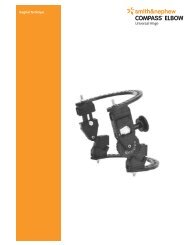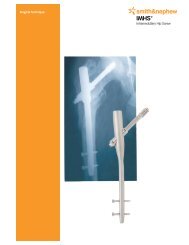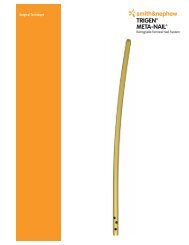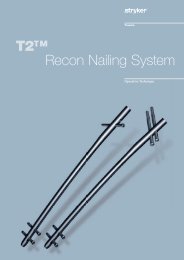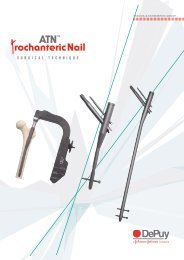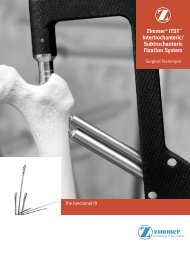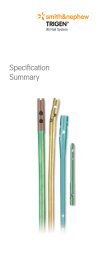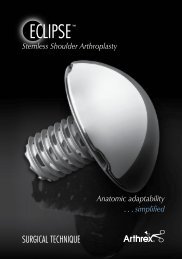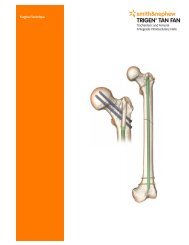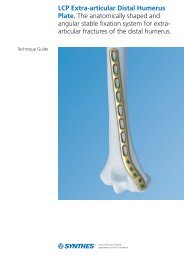Create successful ePaper yourself
Turn your PDF publications into a flip-book with our unique Google optimized e-Paper software.
12<br />
Distal Humerus Plates (cont.)<br />
Step 7: Tap Distal Plate Hole<br />
If using a 3.5mm screw, use the 2.8mm drill or smooth quick<br />
release pin in the path of the wire. If using a 2.7mm screw (osteoporotic<br />
bone), the 2.0mm wire has already created the appropriate<br />
size hole for the screw. Measure drill depth (MS-9022) to determine<br />
screw size. After drilling, connect the tap (PL-ELT1027/35) to<br />
the T-Handle (MS-T1212) and tap the plate. The front end of the<br />
tap will act as a guide to ensure that the locking screw follows the<br />
correct trajectory. Turning the tap one-half turn at a time, tap the<br />
plate taking care not to insert the tap further than the start of the<br />
laser line on the tap threads. (See Tapping Instructions)<br />
Note: The T-Handle (MS-T1212) should only be used with the<br />
plate taps and not for locking or non-locking screw insertion.<br />
Step 8: Insert Distal Locking Screw<br />
Insert the appropriate size tap locking screw. Care should be taken<br />
to not overtighten the screw.<br />
The #3 holes on both the medial and lateral columns are optional.<br />
However, if these holes are used be sure to use locking screws if<br />
locking screws have already been inserted in previous steps.<br />
<strong>Acumed</strong> Single Use Tapping<br />
Instrument Precautions:<br />
Tapping a plate using a plate tap will cause titanium<br />
debris to be generated, which should be removed.<br />
Failure to remove the plate debris can cause, among<br />
other complications, inflammation, cartilage damage,<br />
and patient discomfort. The taps are single surgery<br />
use and should be discarded after each surgery or if<br />
the tap becomes dull or damaged. If the resistance<br />
increases while using a tap, discard the tap immediately.<br />
Breakage to the tap can occur due to excessive<br />
torque or levering and care should be taken to avoid<br />
such conditions. Should breakage occur, carefully<br />
remove all tap pieces.<br />
Tapping Instructions:<br />
• Do not tap deeper than the start of the laser line.<br />
• Clean debris from tap after tapping each hole.<br />
• Irrigate hole prior to tapping.<br />
• Do not tap a slot.<br />
• Do not re-tap a hole (use a non-locking screw).<br />
• Tap by hand, not under power.<br />
• Angle of tapped hole must not exceed 20°.<br />
Step 9A: Drill for Proximal Locking Screw<br />
The remaining locking shaft screws may be inserted at the<br />
surgeon’s discretion. To insert the 2.7mm or 3.5mm locking shaft<br />
screws (COL-xxx0), thread the appropriate size locking drill guide<br />
(MS-LDG27/35) into the locking hole in the plate. Drill with the<br />
appropriate size drill (MS-DC5020 or MS-DC28).



